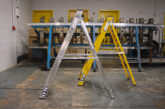
Frank Bertie, Chief Technical Officer at NAPIT, takes a closer look at the requirements for carrying out risk assessments.
Where an electrical installer is involved in carrying out any new work, there has to be a consideration of what the work entails, where it is to be installed, who is to carry out the work and when the work will commence.
With the above in mind, part of health and safety legislation requires a risk assessment of the work process to ensure the engagement of any such work does not present a danger to those carrying out the work, to persons near to the work location or any members of the public that may have access during the work.
In this article we discuss the process and provide a reminder of the risk assessment requirements prior to carrying out any new electrical work.
What does the legislation require?
The Health and Safety at Work Act 1974 (HSWA 1974) and the Management of Health and Safety at Work Regulations (SI 2006 No 438) are both clear in their requirements for carrying out risk assessments and that such information should be recorded and reviewed.
The HSWA 1974 is fundamentally the most important Act that every electrical installer must adhere to at all times. Section 2 (1) of the Regulations states: ‘it shall be the duty of every employer to ensure, so far as reasonably practicable, the health, safety and welfare at work of all of his employees’. Within HSWA, the term ‘his’ is generally interpreted to include all genders.
Although the Act refers to an ‘employer’, by inference it is also applied to those who are ‘self-employed’, considering the self-employed are also responsible for their own safety and those around them, whilst engaged in any working activity.
In addition to the steps previously mentioned, health and safety of members of the public and other workers within the vicinity must be taken into account during the planning of any electrical work.
The Management of Health and Safety at Work Regulations (SI 2006 No 438) (MHSWR 2006) goes a step further than the HSWA 1974, in that it calls directly for risk assessments to be carried out in a multitude of instances.
MHSWR (2006): Section 3(1):
(a) The risks to the health and safety of his employees to which they are exposed whilst they are at work; and
(b) The risks to the health and safety of persons not in his employment arising out of or in connection with the conduct by him of his undertaking.
As can be seen, this reiterates the message of the HSWA 1974. The employer is responsible for his employees as well as anyone who may be affected by their actions. Clearly this is very important, and the MHSWR (2006) gives the same message to self-employed individuals:
MHSWR (2006): Section 3(2):
Every self-employed person shall make a suitable and sufficient assessment of:
(a) The risks to his own health and safety to which he is exposed whilst he is at work; and,
(b) The risks to the health and safety of persons not in his employment arising out of or in connection with the conduct by him of his undertaking.
All risk assessments must be reviewed and revalidated if a change of circumstance becomes apparent as in the following:
MHSWR (2006) Section 3 (3)
Any assessment such as is referred to in paragraph (1) or (2) shall be reviewed by the employer or self-employed person who made it if:
(a) There is reason to suspect that it is no longer valid; or,
(b) There has been a significant change in the matters to which it relates; and whereas a result of any such review changes to an assessment are required, the employer or self-employed person concerned shall make them.
What needs to be considered for new electrical installations?
The Electricity at Work Regulations as well as BS 7671:2018+A2:2022 cover the requirements for electrical installations. Although these regulations refer to risk assessments, these are not considered to be part of the main risk assessment for work activities but do need to be taken into account.
So, we need to look at what type of work is to be carried out as each installation presents particular risks and hazards and steps are required to manage any of the potential risks.
Does the installation include large switchgear and equipment?
This would include machinery to safely move the equipment into place from the delivery to the final position within the premises. The days of manhandling this type of equipment should be long gone due to the dangers of back and muscle injury to persons carrying out this work.
The Health and Safety Executive (HSE) provides a guide on manual handling at work which refers back to MHSWR (2006) and there is further legislation covering the topic Manual Handling Operations Regulations 1992.
Does any of the installation material or methods contain any risks?
All installation work carries a risk. For example, during containment installation, which involves cutting, site manufacture, assembly and fixing, all of these activities must be considered as part of the risk assessment, along with any steps necessary for the provision of suitable personal protective equipment, again subject to legislation recently amended by The Personal Protective Equipment at Work (Amendment) Regulations 2022.
Are any of the installation materials or processes subject to substances hazardous to health?
This is an important area for which there is legislation called Control of Substances Hazardous to Health (COSHH). It covers a wide range of substances and activities, such as dusts resulting from cutting and grinding, lubricants as well as references to COSHH found in the instructions of the relevant manufacturer.
Where is the installation to be carried out?
Each type of premises and location provides a different challenge – from a dwelling to a hospital – which can lead to a more detailed risk assessment being carried out so as to include the range of very particular requirements and regulations to be considered. These could be as follows:
– Is it a new build or existing premises?
– Is the work to be internal or external?
– Is there working at heights involved?
A new build premises would seem to be a more straightforward case, but the activities will operate in a construction site environment, where the main contractor will have a raft of site-specific requirements.
In contrast, with an existing building there may not be construction site issues, but there will be a need to survey or review any records of the materials and services that exist, in order to ensure that appropriate precautions are taken, such as when asbestos is present.
Who is at risk during the proposed work?
Although we’re looking at who is at risk, we do have to remember that everyone has a responsibility to ensure the health and safety of those around them.
With regards to a work task, we’re trying to highlight the areas of risk to those carrying out the work, not just the work task itself, but also any materials or additional items, such as working at height. Additional details would require inclusion for other trades, staff and any members of the public who have access to or are in the vicinity of the work area.
When is the work to be carried out?
This is a crucial consideration as the proposed time for the work task can either increase or decrease the risks associated with the task. Obviously with electrical installation or inspection and testing this would require some form of isolation to allow safe working, therefore arrangements will have to be carried out to allow this during out of normal working hours.
With commercial interests, any downtime for a business is seen as a critical issue, and although domestic premises may seem more straightforward, with many employees now working from home, this also requires to be factored in.
Recording the risk assessment
When carrying out risk assessments it is vital that the records are adequate and accurate, covering all of the risks associated with the planned work activities. Remember that the Certificates, Records and Assessment documentation produced during your current risk assessment will provide the starting point for the review and maintaining safe working in the future.
The method for recording the risk assessment information is only relevant if it is accessible and can be viewed as required. Although paper documentation can be suitable, the use and application of software systems for this purpose provide a more effective resource.
Review and monitoring
Each risk assessment should be unique to the work activity and although part of the information can be reused for future risk assessments, the particulars for each work task must be reviewed. The monitoring of the risk assessments carried out will assist in improving the health and safety of the business by learning and adapting the work processes.
Conclusion
By carrying out the required assessment of the electrical installation, the electrical installer then has the necessary information to be able to commence working with the knowledge that health and safety aspects of the work have been included for the benefit of those carrying out the work and those who may be impacted by it.
For more details on NAPIT’s ‘Risk Assessment and Management Code of Practice’ publication, click here










